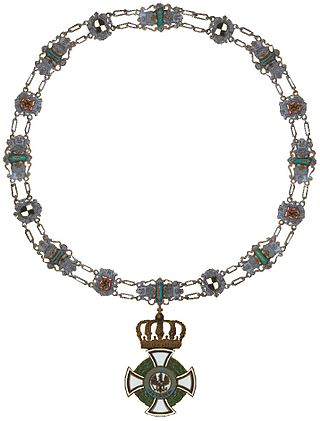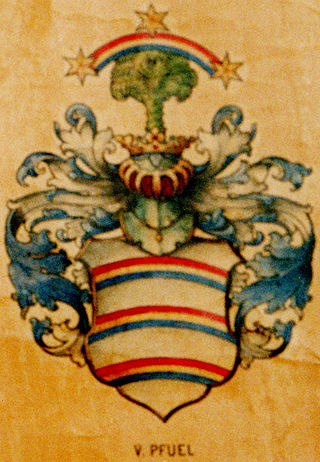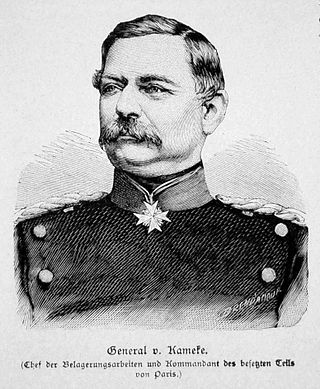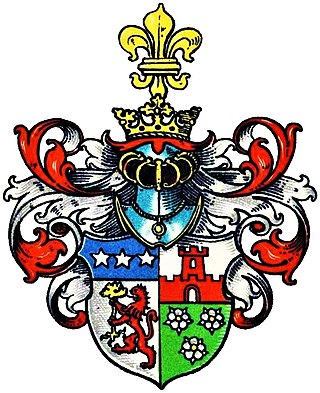
The Pour le Mérite, also informally known as the Blue Max, is an order of merit established in 1740 by King Frederick II of Prussia. The Pour le Mérite was awarded as both a military and civil honour and ranked, along with the Order of the Black Eagle, the Order of the Red Eagle and the House Order of Hohenzollern, among the highest orders of merit in the Kingdom of Prussia. The order of merit was the highest royal Prussian order of bravery for officers of all ranks.

Karl Wilhelm Paul von Bülow was a German field marshal commanding the German 2nd Army during World War I from 1914 to 1915.

The House Order of Hohenzollern was a dynastic order of knighthood of the House of Hohenzollern awarded to military commissioned officers and civilians of comparable status. Associated with the various versions of the order were crosses and medals which could be awarded to lower-ranking soldiers and civilians.

The Military Merit Cross (Militärverdienstkreuz) was established by Friedrich Franz II, Grand Duke of Mecklenburg-Schwerin on August 5, 1848. Mecklenburg-Schwerin, a grand duchy located in northern Germany, was a member of the German Confederation and later the German Empire.

The Pfuel family is an ancient German noble family that arrived to Brandenburg in the year 926 and later widened their influence to Saxony, Saxony-Anhalt, Mecklenburg, Pomerania, Württemberg, Westphalia, Eastern Europe and Sweden.
Karl Graf von der Gröben was a Prussian general.

Arnold Karl Georg von Kameke was a Prussian General of the Infantry and Minister of War.

Carl Heinrich von Wedel was a Prussian lieutenant general in the War of Austrian Succession (1740–1748), the Seven Years' War (1756–1763), and the War of Bavarian Succession (1778–1779). He fought most notably in the Battle of Tornow in 1758, and the Battle of Kay in 1759. He was instrumental in Frederick the Great's victory at Leuthen in December 1757.

Karl Freiherr von Plettenberg was a Prussian officer, and later General of Infantry during World War I. He was Commandant-General of the Guards Corps, Adjutant General of the German Kaiser Wilhelm II and a recipient of Pour le Mérite.
The General Honour Decoration was a civil and military decoration of the Grand Duchy of Hesse. Established 25 September 1843, the medal could be awarded to recognize several different accomplishments or merits, such as military merit, lifesaving and long service. The reason for the award of the medal was determined by the inscription on the reverse of the medal, with the obverse bearing the effigy of the reigning Grand Duke of Hesse.

The Schlieffen family is the name of an old German noble family from Pomerania. The family, branches of which still exist today, originates in Kolberg.

Karl Heinrich Magnus Wilhelm von Wedell-Piesdorf was a German politician for German Conservative Party.

The de Forcade family, sometimes written Forcade (de la), Fourcade (de) and Fourcade (de la), belongs to the nobility of Guyenne.
Friedrich Heinrich Ferdinand Leopold von Forcade de Biaix, aka Heinrich Friedrich Ferdinand Leopold von Forcade de Biaix, aka Friedrich Heinrich Ferdinand Leopold Marquis de Forcade de Biaix, was a Royal Prussian lieutenant colonel. He served in the Prussian Army from 1761 to 1793. His last command was as commanding officer of the 10th Prussian Fusilier Battalion, with which he served in the Rhine Campaigns of 1791, where he was awarded the Kingdom of Prussia's highest military order of merit for heroism, Knight of the Order of Pour le Mérite (1791). He left the Prussian Army after 32 years of service in 1793 as the result of invalidity. At the time of his death, he was the owner of Schleibitz Manor, near Oels, Silesia.
Friedrich Wilhelm von Forcade de Biaix, aka Frideric Guillaume de Forcade was a Royal Prussian Colonel, Schwadronschef of the 2nd Grenadier Company in the 24th Prussian Infantry Regiment, recipient of the Kingdom of Prussia's highest military order of merit for heroism, Knight of the Order of Pour le Mérite (1774), Commandant of Frankfurt/Oder, and Presbyter of the French congregation of Frankfurt/Oder.

The Waldow family or Waldau, is the name of a Bavarian noble family. The family belonged to the German nobility in Nordgau. Originally a Prussian family, they became influential in Brandenburg in the 14th century. The earliest known ancestor is Knight Hentzlinus de Waldow. The family acquired land in Neumark, Meissen, Silesia and Pomerania, where they came to prominence and prestige that they retained until the Second World War.

The House of Knesebeck is the name of two branches of a prominent aristocratic family in the tradition of the ancient nobility in Germany. In the 17th century they acknowledged a common ancestry and combined their arms. The black line of the family von dem Knesebeck stems from the ancient nobility of Lower Saxony, while the white line stems from the ancient nobility of the Altmark. Branches of both lines remain to this day. As one of the leading Prussian Junker families, it has produced numerous senior military and public figures. These have included ambassadors, bishops, governors, members of parliament, a field marshal, and dozens of generals.

The Frydag family, also spelled Vrydach, Freytag, Freydag and various other slightly different spellings, is a German noble family known since the beginning of the 14th century that originated in Uradel in Westphalia.

Prince Heinrich of Hesse and by Rhine was a member of the House of Hesse-Darmstadt and a General of the Cavalry.

Karl, Prince of Wedel, born Karl Leo Julius Graf von Wedel, was a Prussian general and diplomat who served as the fourth Imperial Lieutenant of the Reichsland of Alsace–Lorraine from 27 October 1907 until his resignation on 18 April 1914.
















